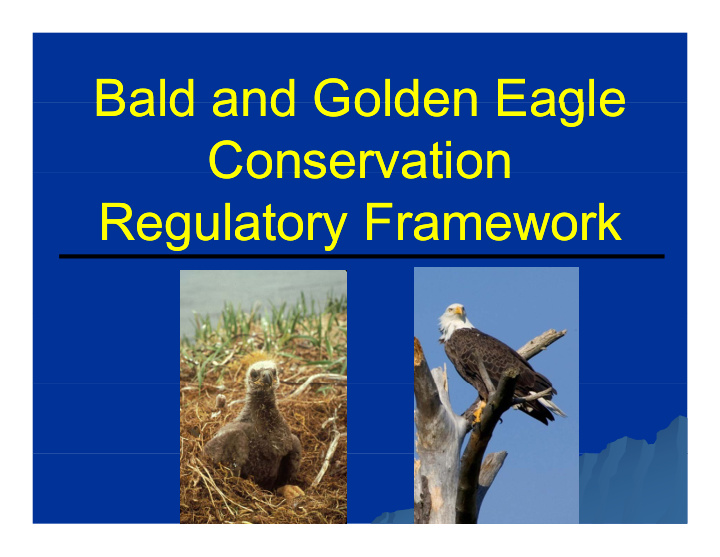



Bald and Golden Eagle Bald and Golden Eagle Bald and Golden Eagle Bald and Golden Eagle Conservation Conservation Conservation Conservation Regulatory Framework Regulatory Framework g g y y
Species Protection Species Protection Species Protection Species Protection Federal Laws: Federal Laws: Federal Laws: Federal Laws: Bald and Golden Eagle Bald and Golden Eagle Protection Act Protection Act i Migratory Bird Treaty Act Migratory Bird Treaty Act State of California State of California State of California State of California Fish and Game Code Fish and Game Code – F ll P F ll P Fully Protected Fully Protected d d
Threats Threats • Poisoning (lead, pesticides) • Collisions C lli i • cars • turbine blades t bi bl d • wires • fences f • Electrocution • Loss of habitat L f h bit t • Declining prey base • Human disturbance H di t b
Population Status of Golden Population Status of Golden Eagles • The status of the population in the western p p US is unclear. Few published data on golden eagle abundance and population trend are g p p available for CA. • Of the data that is available (published and unpublished) a declining population in some p ) g p p portions western North America was noted.
Background on the Eagle Act: Take Definitions • Take ‐ pursue, shoot, shoot at, poison, wound, kill, capture, trap, collect, destroy, molest or disturb • Disturb ‐ to agitate or bother a Bald or Golden eagle to a Di b i b h B ld G ld l degree that causes, or likely to cause, based on best scientific information • injury to an eagle • decrease in productivity by substantially interfering • decrease in productivity, by substantially interfering with normal breeding, feeding, or sheltering behavior • nest abandonment, by substantially interfering with , y y g normal breeding, feeding, or sheltering behavior
Conservation Perspectives of the Eagle Act and Rule Act and Rule • Eagle Act ‐ take will be authorized only where it is “compatible with the preservation of the eagle” • Rule defined as “consistent with the goal of • Rule defined as consistent with the goal of increasing or stable breeding populations” • Higher conservation standard than Endangered Species Act permitting . p p g
Two New Permit Types Established • Intentional take of eagle nests: • Primarily to deal with safety hazard to people or eagles y y p p g • Only inactive nests allowed to be taken except in safety emergencies • Incidental take of eagles • Limited permits available p • Only when take cannot practicably be avoided
Decision for Golden Eagle NEPA on the Rule recognized broad uncertainties • Until additional data show populations of Golden • Until additional data show populations of Golden Eagles can withstand additional take, permits will be considered only for: considered only for: • safety emergencies • programmatic permits • other permits that reduce ongoing take or result in no net loss to the breeding population
Programmatic Permits • Programmatic take ‐ take • Programmatic take take that is recurring and not in a specific identifiable specific, identifiable timeframe and/or location • Wind Energy Facilities • Power Tower Solar Facilities • Power Tower Solar Facilities • Utility Lines y
Programmatic Permit Measures • Authorizations will be based on A th i ti ill b b d implementation of “advanced conservation practices” practices • “Advanced Conservation Practices” (ACPs) are scientifically supportable measures approved by the Service • Represent the best available techniques to reduce eagle take to a level where g remaining take is unavoidable
Site- Site -Specific Specific NEPA Analyses NEPA Analyses for Programmatic Permits for Programmatic Permits •Should include at least the following: Sh ld i l d t l t th f ll i •Nest inventory & territory delineation •Available occupancy & productivity data •Available occupancy & productivity data •Migration corridors •Winter use areas •Line ‐ of ‐ site evaluation •Eagle use patterns (breeding and non ‐ breeding) •Known foraging areas •Potential mitigation •Cumulative effects •Cumulative effects
Mitigation • Sequential approach to mitigation • Avoid • Minimize • Rectify • Rectify • Reduce or eliminate over time • Compensate ‐ is last!
Golden Eagle Permitting Challenges • Declining populations and limited data in CA and NV • Few proven avoidance measures for wind • Limited data to support that compensation measures are Limited data to support that compensation measures are effective to offset impacts to the species • Current financial incentives are driving the timelines • Current financial incentives are driving the timelines • Limited Service staff and funding to implement program • Cumulative Impacts may be individually minor, but collectively significant over time.
Cumulative Impacts • May be individually minor, but collectively significant over time significant over time. • Multiple Wind Resource Areas • Little mortality data available
Data Gaps and Outstanding Questions •Territory size and use in xeric (dry) y y habitats •Survival and causes of mortality •Survival and causes of mortality •Population size and trend p •Seasonal movements •Habitat use patterns •Migration patterns •Migration patterns •Genetic structure
FWS Siting and Permitting Tools FWS Siting and Permitting Tools FWS Siting and Permitting Tools FWS Siting and Permitting Tools FWS Wind Energy Guidelines gy • Based on recommendations from the Federal Advisory Committee • Revised document expected in early 2012 • Revised document expected in early 2012 Eagle Conservation Plan Guidance • Under development since May 2011 • Version 2 out in early 2012 for public comment Region 8 ABPP template CA/NV Golden Eagle Working Group C ll b Collaboration with other Federal and State agencies i i h h F d l d S i permitting projects
Summary Incidental Take Permits are available Permitting standards are Permitting standards are difficult to meet Lack of acceptable compensation measures is frustrating the industry
Recommend
More recommend